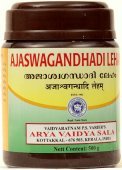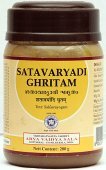Madhuyashti, Madhuyaṣṭi, Madhu-yashti, Madhuyaṣṭī: 10 definitions
Introduction:
Madhuyashti means something in Hinduism, Sanskrit, Marathi, biology. If you want to know the exact meaning, history, etymology or English translation of this term then check out the descriptions on this page. Add your comment or reference to a book if you want to contribute to this summary article.
The Sanskrit terms Madhuyaṣṭi and Madhuyaṣṭī can be transliterated into English as Madhuyasti or Madhuyashti, using the IAST transliteration scheme (?).
In Hinduism
Ayurveda (science of life)
Cikitsa (natural therapy and treatment for medical conditions)
Source: Ancient Science of Life: Botanical identification of plants described in Mādhava CikitsāMadhuyaṣṭī (मधुयष्टी) refers to the medicinal plant Glycyrrhiza glabra L., and is used in the treatment of atisāra (diarrhoea), according to the 7th century Mādhavacikitsā chapter 2. Atisāra refers to a condition where there are three or more loose or liquid stools (bowel movements) per day or more stool than normal. The second chapter of the Mādhavacikitsā explains several preparations [including Madhuyaṣṭī] through 60 Sanskrit verses about treating this problem.
The plant Glycyrrhiza glabra L. (Madhuyaṣṭī) is also known as Yaṣṭī according to both the Ayurvedic Formulary and the Ayurvedic Pharmacopoeia of India.

Āyurveda (आयुर्वेद, ayurveda) is a branch of Indian science dealing with medicine, herbalism, taxology, anatomy, surgery, alchemy and related topics. Traditional practice of Āyurveda in ancient India dates back to at least the first millenium BC. Literature is commonly written in Sanskrit using various poetic metres.
Biology (plants and animals)
Source: Wisdom Library: Local Names of Plants and DrugsMadhuyashti [मधुयष्टि] in the Marathi language is the name of a plant identified with Abrus precatorius L. from the Fabaceae (pea) family. For the possible medicinal usage of madhuyashti, you can check this page for potential sources and references, although be aware that any some or none of the side-effects may not be mentioned here, wether they be harmful or beneficial to health.
Source: Google Books: CRC World Dictionary (Regional names)1) Madhuyashti in India is the name of a plant defined with Glycyrrhiza glabra in various botanical sources. This page contains potential references in Ayurveda, modern medicine, and other folk traditions or local practices It has the synonym Liquiritia officinarum Medik., nom. illeg. superfl. (among others).
2) Madhuyashti is also identified with Saccharum officinarum It has the synonym Saccharum officinarum var. tahitense Kunth (etc.).
Example references for further research on medicinal uses or toxicity (see latin names for full list):
· Descriptiones et Icones Plantarum Rariorum Hungariae (1800)
· Monographiae Phanerogamarum (1889)
· Adnotationes Botanicae (1829)
· Flore des Antilles (1808)
· Flora Orientalis (1872)
· Enumeratio Plantarum Omnium Hucusque Cognitarum (1833)
If you are looking for specific details regarding Madhuyashti, for example diet and recipes, health benefits, pregnancy safety, side effects, extract dosage, chemical composition, have a look at these references.

This sections includes definitions from the five kingdoms of living things: Animals, Plants, Fungi, Protists and Monera. It will include both the official binomial nomenclature (scientific names usually in Latin) as well as regional spellings and variants.
Languages of India and abroad
Marathi-English dictionary
Source: DDSA: The Molesworth Marathi and English Dictionarymadhuyaṣṭi (मधुयष्टि) [or मधुयष्टिका, madhuyaṣṭikā].—f S (Sweet stick.) Sugarcane: also the root of Abrus precatorius, used as Licorice.
Marathi is an Indo-European language having over 70 million native speakers people in (predominantly) Maharashtra India. Marathi, like many other Indo-Aryan languages, evolved from early forms of Prakrit, which itself is a subset of Sanskrit, one of the most ancient languages of the world.
Sanskrit dictionary
Source: DDSA: The practical Sanskrit-English dictionaryMadhuyaṣṭi (मधुयष्टि) or Madhuyaṣṭī (मधुयष्टी).—f.
1) sugar-cane.
2) liquorice.
Derivable forms: madhuyaṣṭiḥ (मधुयष्टिः).
Madhuyaṣṭi is a Sanskrit compound consisting of the terms madhu and yaṣṭi (यष्टि).
Source: Cologne Digital Sanskrit Dictionaries: Shabda-Sagara Sanskrit-English DictionaryMadhuyaṣṭi (मधुयष्टि).—f.
(-ṣṭiḥ) Sugar-cane. E. madhu honey, and yaṣṭi a cane or stick.
Source: Cologne Digital Sanskrit Dictionaries: Monier-Williams Sanskrit-English Dictionary1) Madhuyaṣṭi (मधुयष्टि):—[=madhu-yaṣṭi] [from madhu] f. sugar-cane, [cf. Lexicographers, esp. such as amarasiṃha, halāyudha, hemacandra, etc.]
2) [v.s. ...] liquorice, [cf. Lexicographers, esp. such as amarasiṃha, halāyudha, hemacandra, etc.]
3) [v.s. ...] = tiktaparvan, [cf. Lexicographers, esp. such as amarasiṃha, halāyudha, hemacandra, etc.]
4) Madhuyaṣṭī (मधुयष्टी):—[=madhu-yaṣṭī] [from madhu] f. liquorice, [cf. Lexicographers, esp. such as amarasiṃha, halāyudha, hemacandra, etc.]
Source: Cologne Digital Sanskrit Dictionaries: Yates Sanskrit-English DictionaryMadhuyaṣṭi (मधुयष्टि):—[madhu-yaṣṭi] (ṣṭiḥ) 2. f. Sugar-cane.
[Sanskrit to German]
Sanskrit, also spelled संस्कृतम् (saṃskṛtam), is an ancient language of India commonly seen as the grandmother of the Indo-European language family (even English!). Closely allied with Prakrit and Pali, Sanskrit is more exhaustive in both grammar and terms and has the most extensive collection of literature in the world, greatly surpassing its sister-languages Greek and Latin.
See also (Relevant definitions)
Partial matches: Yashti, Madhu, Matu.
Starts with: Madhuyashtika, Madhuyashtike.
Full-text: Atisamya, Madhuyashtika, Tiktaparvan, Yashti, Sudarshanaphanta, Glycyrrhiza glabra, Varṇya.
Relevant text
Search found 7 books and stories containing Madhuyashti, Madhuyaṣṭi, Madhuyasti, Madhu-yashti, Madhu-yaṣṭi, Madhuyaṣṭī, Madhu-yaṣṭī, Madhu-yasti; (plurals include: Madhuyashtis, Madhuyaṣṭis, Madhuyastis, yashtis, yaṣṭis, Madhuyaṣṭīs, yaṣṭīs, yastis). You can also click to the full overview containing English textual excerpts. Below are direct links for the most relevant articles:
Trishashti Shalaka Purusha Caritra (by Helen M. Johnson)
Appendix 6.2: new and rare words < [Appendices]
Brihat Samhita (by N. Chidambaram Iyer)
The Agni Purana (by N. Gangadharan)
The Garuda Purana (by Manmatha Nath Dutt)
Chapter CCXXVII - Different names of the Ayurvedic Drugs < [Dhanvantari Samhita]
Amarakoshodghatana of Kshirasvamin (study) (by A. Yamuna Devi)
The Brahmanda Purana (by G.V. Tagare)
Chapter 14 - Purification rites and the Śrāddha ritual < [Section 3 - Upodghāta-pāda]
Related products

